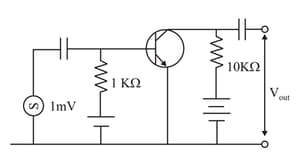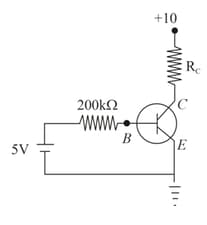Transistor as an Amplifier
Transistor as an Amplifier: Overview
This Topic covers sub-topics such as Transistor as an Amplifier, Common Emitter Amplifier, Current Amplification in Common Emitter Amplifier and, Phase Relationship of Input and Output Signal in Common Emitter Amplifier
Important Questions on Transistor as an Amplifier
Which one is the correct formula for the power gain of a CE amplifier?
CE and CB, both have the same phase difference for input and output signal.
Which one of the given has a phase difference in input and output signal?
For the CE amplifier, the phase difference between input and output single is not .
Due to phase difference, the CE amplifier is known as _____.
In a common emitter amplifier circuit using an transistor, the phase difference between the input and the output voltages will be:
In the following common emitter configuration, an transistor with a current gain is used. Find the value of output voltage of the amplifier

In a transistor amplifier, the collector load resistance is and input resistance is . If the current gain is , calculate voltage gain of the amplifier.
In a common base mode of a transistor, the collector current is for an emitter current of . The value of the base current amplification factor will be
If the base and collector of a transistor are in forward biased, it is not used as a :-
In a transistor amplifier, the audio signal voltage across the collector resistance of is If the base resistance is and the current amplification of the transistor is the input signal voltage is :
If -current gain of a transistor is . What is the value of -current gain of the transistor?
To use a transistor as an amplifier
The transistors provide good power amplification when they are used in
When the transistor is used as an amplifier, then
An transistor is biased to work as an amplifier, which of the following statements is not correct?
In an npn transistor, electrons enter the emitter in second. If electrons entering to emitter are lost in the base, the fraction of current that enters the collector and current amplification factor are respectively:
For a amplifier, the current gain is. If the emitter current is , then the base current will be,
In an npn transistor, electrons enter the emitter in second. If electrons are lost in the base,
the fraction of current that enters the collector and current amplification factor are respectively:
In given transistor circuit, at saturation mode and . Then, the required value of for which transistor remains in saturation mode, will be:-

